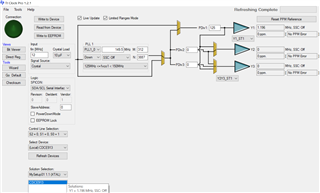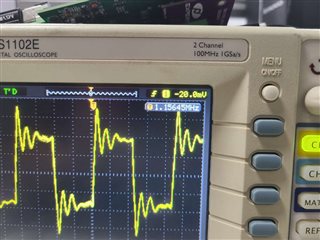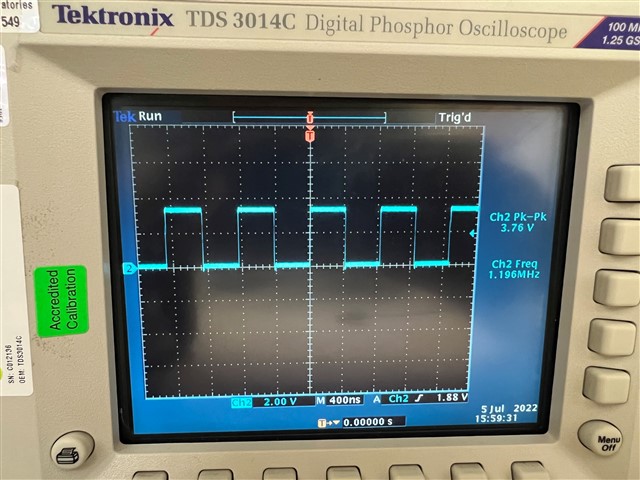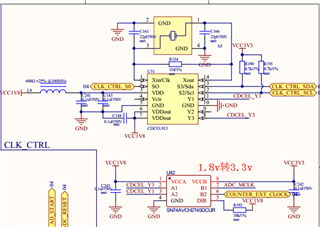Other Parts Discussed in Thread: CDCE913, , CLOCKPRO
Hi team,
Customer input frequency is 12MHz, target output frequency is 1196kHz.
The customer has developed the following code, which is the correct code to calculate and set some of the frequencies for cdce913. However, the output target frequency of 1196kHz is set and the actual oscilloscope measures 1160kHz.
/** CDCEL913芯片外接晶振频率 单位:kHz*/
#define CLK_IN 12000
/**
* @Description:调整ad芯片的输入频率
* @param f_out 目标频率 单位:百Hz
* @return NULL
*/
void CDCE_Init_set(float f_out)
{
uint8_t i = 0;
uint32_t correctnum = 0;
uint32_t M, N, Q, R;
float Pdiv;
uint8_t reg18, reg19, reg1A, reg1B;
int32_t P;
float f_vco = 0;
uint8_t f_odr=1;
printf("f_out:%f\r\n", f_out);
//a = (float)(f_out / (float)1000.0f);
f_out = (f_out / 1000.0f);
printf("f_out :%f\r\n", f_out);
begin:
i = 0;
f_vco = f_out;
printf("f_vco :%f\r\n", f_vco);
f_odr = f_vco/1000;
bool result = false;
uint8_t f_range;
if (f_out <= 0) return;
if(f_odr<8)
{
while (f_vco < f_odr*12 * 1000)
{
i++;
f_vco = f_out * i;
}
}
else
{
while (f_vco < 84 * 1000)
{
i++;
f_vco = f_out * i;
}
}
while (f_vco < 231 * 1000)
{
for (N = 4095; N > 0; N--)
{
for (M = 511; M > 0; M--)
{
if(((uint32_t)(f_vco * 1000) % 1000 == 0))
{
if ((uint32_t)((N * (CLK_IN) / M)) == (uint32_t)(f_vco))
{
result = true;
break;
}
}
else
{
if(((uint32_t)((float)N * (float)(CLK_IN) / (float)M) + correctnum) == (uint32_t)((f_vco * 1000) / 1000))
{
{
result = true;
break;
}
}
}
}
if (result)
{
break;
}
}
if (result)
{
break;
}
else
{
i++;
f_vco = f_out * i;
}
}
printf("M:%d\r\n", M);
printf("N:%d\r\n", N);
printf("f_vco:%f\r\n", f_vco);
if(((M == 0) && (N == 0)) || (f_vco > 231 * 1000))
{
if(correctnum < 11)correctnum++;
else correctnum = 1;
printf("refind M N\r\n");
goto begin;
}
P = 4 - (int)((log((double)N / (double)M)) / log(2));
if (P < 0)
{
P = 0;
}
Q = (int)((double)N * pow(2, (double)P) / (double)M);
R = (double)N * pow(2, (double)P) - M * Q;
if (f_vco < 125 * 1000)
{
f_range = 0;
}
else if ((f_vco >= 125 * 1000) && (f_vco < 150 * 1000))
{
f_range = 1;
}
else if ((f_vco >= 150 * 1000) && (f_vco < 175 * 1000))
{
f_range = 2;
}
else
{
f_range = 3;
}
Pdiv = (uint32_t)(f_vco) / (uint32_t)(f_out);
printf("f_vco:%f\r\n", f_vco);
printf("Pdiv:%d\r\n", (uint8_t)Pdiv);
cdce913_I2C_WriteByte(0x02, 0xB4);
cdce913_I2C_WriteByte(0x03, (uint8_t)Pdiv);
cdce913_I2C_WriteByte(0x04, 0x02);
cdce913_I2C_WriteByte(0x05, 0x50);
cdce913_I2C_WriteByte(0x06, 0x40);
cdce913_I2C_WriteByte(0x10, 0x00);
cdce913_I2C_WriteByte(0x11, 0x00);
cdce913_I2C_WriteByte(0x12, 0x00);
cdce913_I2C_WriteByte(0x13, 0x00);
cdce913_I2C_WriteByte(0x14, 0x0d); //Y2,Y3开关控制,y1不是该引脚控制,固定有Y1
cdce913_I2C_WriteByte(0x15, 0x02);
cdce913_I2C_WriteByte(0x16, 0);
cdce913_I2C_WriteByte(0x17, 0);
reg18 = (N >> 4) & 0xFFF;
reg19 = (N & 0xf) << 4 | (R & 0xf0) >> 5;
reg1A = (R & 0x1f) << 3 | ((Q >> 3) & 0x7);
reg1B = (Q & 0x7) << 5 | (P & 0x07) << 2 | (f_range & 0x03);
cdce913_I2C_WriteByte(0x18, reg18);
cdce913_I2C_WriteByte(0x19, reg19);
cdce913_I2C_WriteByte(0x1A, reg1A);
cdce913_I2C_WriteByte(0x1B, reg1B);
cdce913_I2C_WriteByte(0x1C, N);
cdce913_I2C_WriteByte(0x1D, ((N & 0xf) << 4) | (R & 0xf0));
cdce913_I2C_WriteByte(0x1E, (R & 0x0f) | (Q & 0xf0));
cdce913_I2C_WriteByte(0x1F, ((Q & 0x07) << 5) | ((P & 0x07) << 2) | (f_range & 0x03));
/** 使能时钟输出*/
HAL_GPIO_WritePin(CLK_CTRL_S0_GPIO_Port, CLK_CTRL_S0_Pin, GPIO_PIN_SET);
}

The customer places the M , N , fvco and Pdiv1 values generated by Pro-Clock software directly into the register, the software shows output 1.196 MHz, but the actual test output is around 1.156 MHz

So I wonder if this is normal?
What is the accuracy of the CDCEL913 output frequency? Or maximum deviation?
Best Regards,
Amy Luo




